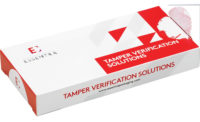Diversify or Die: Flexo Helps Palmas Printing Transition to Flexible Packaging Market
While Melbourne, Fla.-based Palmas Printing certainly isn’t new to package printing, it is fairly new to printing on flexible film – and Jim Love, Palmas’ VP, has no issue admitting it.
“We’re not a new company, but we’ve basically made a transition from being a label printer to a flexible packager and we’ve managed to do it without going out of business,” he says.
But Love also admits that Palmas was “a hair away” from closing shop. And to truly understand how Palmas got to where it is at now, you’d need to know the company’s backstory. George Schmitt & Co. is a printing, converting and finishing firm that has been in business since 1874. One of the markets the company has excelled in is tobacco packaging and printing. When many of its large cigar clients began opening shop in Puerto Rico in the 1970s, George Schmitt & Co. opened Palmas Printing as a subsidiary in Juncos, Puerto Rico to better serve these clients. Palmas Printing originally consisted of a single gravure press focused on printing rolled cigar bands. As the business grew, Palmas added capacity and eventually expanded into pressure-sensitive labels.
“When flavors came out for cigars, the traditional brands went into line extensions and became different flavored versions of well-known cigars,” Love says. “That kind of killed gravure because the cylinder changes and the setup times and the runs all went another direction and we needed a more cost-effective way to do shorter runs. We got into flexo at that point.”
Things were going good for Palmas Printing. Love says the company owned about 95 percent of the mass market in the cigar industry. And then things changed in the late 2000s following the company’s move from Puerto Rico to its current location in Melbourne, Fla. With the proliferation of flavors in the cigar industry, metalized wrappers soon started to displace bands. Palmas didn’t have the right equipment to print on the unsupported film material.
“We very quickly decided that we had to spend a whole lot of money to re-tool and take advantage of the relationships that we’ve had for so many years with these tobacco companies,” Love says. “If we didn’t get into flexible packaging, we weren’t going to have a business.
“We started spending all of our money on new equipment. Right after that happened, in 2010, pouches began to cannibalize wrappers. That continues today – now wrappers are a much smaller part of our business and pouches are our primary business – and it’s growing. That’s required more equipment. Now, instead of just printing a cigar band and a film wrapper, we’re doing the film printing and the laminating and the forming of the pouch, including a zipper closure.”
Today, Palmas Printing only does flexographic printing. It operates five flexo presses and is capable of printing in up to 10 colors and up to 17 inches in web widths (31 inches with partners). While Love admits that he loved the high-quality and repeatability of gravure printing, it became non-competitive from a cost standpoint when Palmas was forced to transition into printing shorter runs. Flexo’s fast set up time and inexpensive operating costs – especially when it comes to short print runs – were the basis behind Palmas’ decision to adopt the technology.
Today, Palmas is growing – and growing fast. Love estimates that from when he started at the company in 1993 to today, sales are up 300 percent. But this growth hasn’t come without some growing pains.
“Printing on film was a whole different animal because it’s an extensible substrate – the tension was critical,” he says.
“When we went to unsupported film, you’ve got that factor, which is tension and winding. In addition to that, you have a whole different dynamic of printing with adhesion and curing. We had a lot of help from suppliers, manufacturers, partners – it was touch-and-go for a number of years there to really master printing on film. These are multi-wall constructions that require lamination between, so you’ve got a lot of winding going on, you’ve got coating going on, printing on substrates that you’ve got to raise the surface energy so you can get adhesion – it’s just a whole different animal and not nearly as forgiving as printing on paper was.”
Aside from learning how to be a good flexible packaging printer, Palmas’ transition into flexible packaging also provided the company with another important lesson – the importance of diversification.
While tobacco is still the main industry that Palmas serves, it has also begun to make some headway into the food and beverage, consumer products and household products markets. Love sees these markets as the future of the company, especially on the regional level. And Palmas is continuing to invest in its operation. It’s since added a facility in the Dominican Republic (about 75 employees work between the Melbourne and Dominican Republic facilities), is currently adding two finishing machines to its operations and is considering adding new narrow and wide web presses.
“I think a company that stops reinventing itself is in the process of dying, whether it’s over a short period or a long period,” Love says. “There are many great companies in this country that don’t exist anymore that were big players in the past. This company, as small as it is, has demonstrated a resilience and an ability to adapt.”
Palmas was forced to reinvent itself or go out of business, and over the course of the past six years has transformed from a label printer to a flexible packaging provider.
Palmas Printing
(321) 984-4451
www.palmasprinting.com
Digital Printing Helps Take on Social Issues
“You need to know how to use digital. If you want to use it to print the same thing you were printing conventional, that’s a huge mistake. You really have to take advantage and get the best out of it.”
That’s Alejandro Espana, chairman of the board of Mexico-based Ercus Group, which has a packaging business unit that particularly specializes in printing on flexible materials. While Ercus Group does work with several U.S. companies, most of its clients are based in Mexico, South America and Central America. And for the past five years, the company has printed with nothing but digital presses.
“We used to use gravure presses,” he says. “You can imagine the amount of plates, preparing the ink to print in small volume. The cost of printing was really expensive and the quality wasn’t amazing.”
Today, Ercus exclusively uses HP digital presses, and he says transitioning from conventional printing means to digital has presented a savings of about 40 percent. But where digital has really paid off for Ercus Group is in the various projects that it has been able to carry out. The first was the company’s involvement in the Share a Coke campaign, where it printed 670 million labels for the campaign’s efforts in Mexico, which just so happens to be the second-largest market for the Coke brand.
The other notable project has the potential to be much more impactful. Known as “Franqueza,” it’s intended to help solve a social problem. Most coffee farmers in Mexico have limited means to grow their businesses. So in order to help them tell their story, Ercus is printing the farmers’ photos, maps of where the coffee is grown and their stories on the backs of pouches containing their grown coffee. Due to the short runs involved and various farmers that were featured, digital printing was the ideal technology for the project.
Franqueza officially launched in October and is currently available at various Mexico retailers including Walmart, the country’s largest retail chain.
“Packaging is the ultimate marketing tool,” Espana says. “How can digital printing help solve a social problem? Everybody says that they’re helping people, we’re actually showing it.
“How can you tell a story through packaging? How can you talk to the customer directly through packaging? How can you help medium and small companies get into big markets with the quality that they would never get before? Eighty percent of the world is small- to medium-sized businesses. That’s the real market for digital printing.”
Ercus Group
+52(55) 5354 0700
www.grupoercus.com
Gravure, Flexo and Offset… With a Touch of ‘Green’
Ken Fontaine is the president and CEO of Amgraph Packaging, a company that celebrated its 30th anniversary in 2014. Some 140 employees work the 20 processing lines that occupy Amgraph’s 150,000-square-foot facility in Versailles, Conn., serving the food and beverage, tobacco, nutraceutical and industrial markets.
It prints with what Fontaine calls the three major print technologies – offset, gravure and flexo (he also admits that they’re taking a hard look at digital). In fact, he says Amgraph was among the first companies in the U.S. to use offset with flexible packaging, having since gotten more involved with gravure and flexo.
“All of our printing we do is really high-end,” he says. “Our capabilities are very broad.”
But what really makes Amgraph stick out from other printers is its focus on sustainability and eco-friendliness in all of its operations, including printing.
“All printing on our offset side is electron beam printing, so we have zero VOCs,” Fontaine says. “On the gravure side, all of our inks are water-based. On our gravure lines, the coatings are all electron beam also. Our flexo is all water-based flexo.
“Before LEED was a buzzword, we’ve always been water-based or EB since our inception. We’ve never had any solvent in our facility everywhere. Our building is environmentally friendly. You can do it and still remain economically viable. So if you can do that and be a good corporate citizen to the environment, why not?”
Amgraph has been more than able to stay economically viable. It serves customers all throughout North America and the Caribbean, from companies that only do $10 million in revenue to those that do $70 billion. And it continues to invest in its eco-friendliness. In 2009, it opened a “green plant” expansion to its Versailles building, a LEED-certified addition featuring geothermal heating and cooling and an insulated concrete form to minimize heat transfer. In early 2016, Fontaine expects the building to be powered by 100 percent Class I renewable energy following the installation of two fuel cells.
“That’s a very big thing,” he says.
Amgraph
(860) 822-2000
www.amgraph.com








